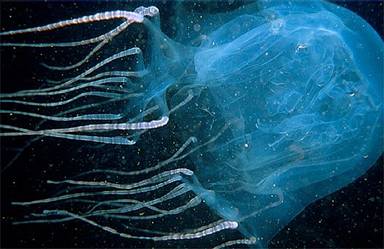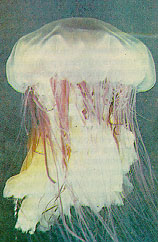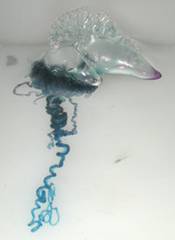Versione Italiana
JELLYFISH
Luciano Schiazza M.D.
Dermatologist
c/o InMedica - Centro Medico Polispecialistico
Largo XII Ottobre 62
cell 335.655.97.70 - office 010 5701818
www.lucianoschiazza.it
Dedicated to holidays. This is the sense of what you are about to read. In fact it is during holidays that we can come across some dangerous sea species unknown or underestimated by the majority of people. We are in fact talking about the damages to our skin provoked by some particular inhabitants of the sea.
We are going to talk about:

They belong to the coelenterate family, to which also belong actiniae and corals. They have umbrella shape from which come out many tentacles. They are mainly made of water, don’t have muscles and drift on the surface following the current. They normally live alone, but they can be seen in groups.
The danger comes from the tentacles or near to the mouth. Here in fact, there are small organules, called cnidocytes having inside a few urticant vescicles (nematocysts) full of toxins. They are violently expelled (2-5 lb – 0.9/2 kg- per square foot) when the jellyfish is touched: they penetrate the skin and, through a thin filament they release toxic substances
Clic on image to enlarge
The severeness of the sting changes according to the species, dimension, geographic area and season: in fact the intensity of the pain varies from a more or less intense pain (similar to the one of a scald) to the irritation of the skin, up to an unbearable pain with severe injury of the skin, weakness, nausea, vomit, breathing difficulties, cramps and muscular pain, hypotension.
The skin injuries are often linear as to reproduce the shape of tentacles and they come out after a few minutes or hours, subject to the contact intensity and the quantity of toxins absorbed by the skin.

In our seas jellyfish are frequently observed: in Liguria one of the most common jellyfish is Rhizostoma pulmo. It has a milk white-slightly blue color, the umbrella is surrounded by purple edges. The diameter can exceed 50-60 cm, with short and dumpy tentacles. To be absolutely avoided is the Pelagia noctiluga also called “fluorescent” jellyfish, due to its fluorescence that makes it visible at night: small and intensely urticant, it can be often see in extended shoals near to the shore. The diameter of its umbrella is roughly 10 cm, its color purple, pink or brown and the length of its tentacles can reach 40 cm. Cnidocytes are in both: tentacles and umbrella.

The most dangerous jellyfish cannot be found in the Mediterranean sea, but in Northern Australia: it is the Chironex fleckeri, also called “box or cube jellyfish) for the quadrangular shape, also named by the Philippino and Japanese fishmen “Fire jellyfish”. It is small (the diameter measures 5-6 cm) with tentacles extending from a few centimeters to a few meters, transparent. The extremely painful stings inoculate a neurotoxic poison that can cause death in a short time. It hides in low waters among mangrovia roots, at the river mouths. During the dry season (May/October) it leaves the costal area and moves to the open sea. They are said to make more victims than sharks.

Out of curiosity: the biggest jellyfish lives in the Artic Sea: it is the Cyanea artica, known as Lion’s mane. Its umbrella has two and a half meters diameter and tentacles reach the length of 40 meters

To be mentioned is also the Physalia Phisalis, known as Portuguese Caravel. It lives in Tropical seas. It has a floating upper part similar to an inflated blue plastic bag (which can be confused with water and makes therefore difficult to spot it), with very thin tentacles, translucent, they can reach the length of 40 meters. Their toxicity can be compared to the one of a cobra snake.


First Aid
-
First of all check vital functions
-
The victim has to be relaxed, for pain and stress may cause
Muscular activity that helps the diffusion of the toxin. -
Wash the wound with sea water, possibly lukewarm. Never use fresh water or ice, for they may cause the opening of the nematocysts still sitting in the skin.
-
The application of warm sand can be a helpful first aid
-
Vinegar can be used diluted at 50% with lukewarm water and applied as a compress on the affected area for 10- 15 minutes.
-
If there are still a few neomacyst in the skin never use bare hands to take them out. Use tweezers, shaving foam or soap and razor to shave them out. In alternative use sand mixed with sea water, talcum powder or flour and gently shave with a sharp knife: do not rub the skin!
-
Seek medical advice: in fact it would be useful the treatment with a cortison cream to alleviate the skin reaction and pain killers to alleviate the pain.
-
a shower can be taken after treatment
